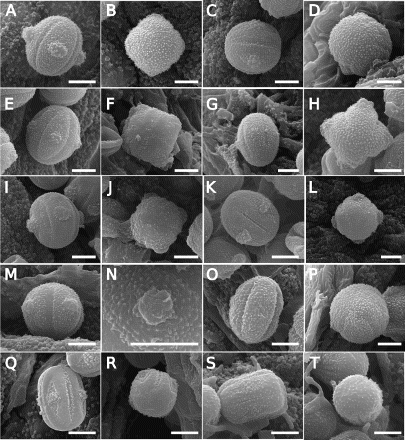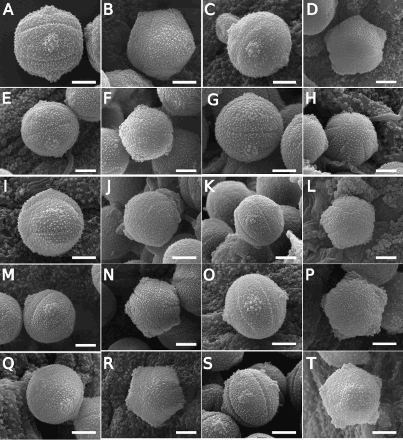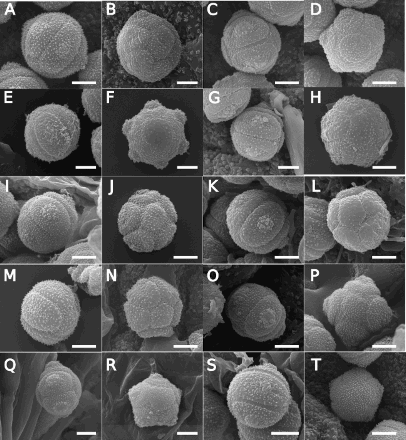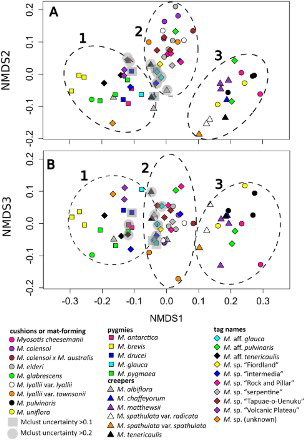Figures & data
Figure 1. Scanning electron microscope (SEM) images of Southern Hemisphere bracteate-prostrate Myosotis pollen showing different pollen types, features and terminology in equatorial view (A–G) and polar view (H–I). A, Myosotis discolor type pollen of M. brevis (WELT SP090543/A) with distinctive lack of granula on most of exine (psilate; white arrow) and alternating colpori (c) and pseudocolpi (pc); B, Myosotis angustata type pollen of M. glabrescens (WELT SP044913) with distinctive oblong (rectangular) shape; C, Myosotis australis type pollen of M. sp. “Volcanic Plateau” (CHR 310610) with wide and psilate pseudocolpus (white arrow); D, close up of M. brevis (WELT SP090550/A) pollen with granulate endoaperture (en) and ektoaperture (ek) membranes of the colporus (c), and psilate membrane of the pseudocolpus (pc), as well as granulate aperture margins (white arrows); E, Myosotis australis type pollen of M. lyallii (CHR 207153) with partially anastomosing pseudocolpi (pc; white arrow); F, Myosotis uniflora type pollen of M. matthewsii (AK 46608) with distinctive polar cap (p cap); G, close up of M. colensoi × M australis (WELT SP090554) colporus with granula (g) on exine and ektoaperture (ek) membrane, and verruca (v) on endoaperture (en) membrane; H, Myosotis australis type pollen of M. glauca (CHR 191750) in polar view, which lacks a polar cap (white arrow); I, Myosotis uniflora type pollen of M. pulvinaris (OTA 031024) in polar view, with fully anastomosing pseudocolpi (pc; white arrow) forming a distinctive polar cap (p cap). pc, pseudocolpus; c, colporus (a compound aperture comprised of ektoaperture [ek] and endoaperture [en]); p cap, polar cap; v, verruca; g, graunula. Scale bar = 5 μm.
![Figure 1. Scanning electron microscope (SEM) images of Southern Hemisphere bracteate-prostrate Myosotis pollen showing different pollen types, features and terminology in equatorial view (A–G) and polar view (H–I). A, Myosotis discolor type pollen of M. brevis (WELT SP090543/A) with distinctive lack of granula on most of exine (psilate; white arrow) and alternating colpori (c) and pseudocolpi (pc); B, Myosotis angustata type pollen of M. glabrescens (WELT SP044913) with distinctive oblong (rectangular) shape; C, Myosotis australis type pollen of M. sp. “Volcanic Plateau” (CHR 310610) with wide and psilate pseudocolpus (white arrow); D, close up of M. brevis (WELT SP090550/A) pollen with granulate endoaperture (en) and ektoaperture (ek) membranes of the colporus (c), and psilate membrane of the pseudocolpus (pc), as well as granulate aperture margins (white arrows); E, Myosotis australis type pollen of M. lyallii (CHR 207153) with partially anastomosing pseudocolpi (pc; white arrow); F, Myosotis uniflora type pollen of M. matthewsii (AK 46608) with distinctive polar cap (p cap); G, close up of M. colensoi × M australis (WELT SP090554) colporus with granula (g) on exine and ektoaperture (ek) membrane, and verruca (v) on endoaperture (en) membrane; H, Myosotis australis type pollen of M. glauca (CHR 191750) in polar view, which lacks a polar cap (white arrow); I, Myosotis uniflora type pollen of M. pulvinaris (OTA 031024) in polar view, with fully anastomosing pseudocolpi (pc; white arrow) forming a distinctive polar cap (p cap). pc, pseudocolpus; c, colporus (a compound aperture comprised of ektoaperture [ek] and endoaperture [en]); p cap, polar cap; v, verruca; g, graunula. Scale bar = 5 μm.](/cms/asset/09e4f470-6315-4266-bfce-66eab6799854/tnzb_a_1229343_f0001_b.gif)
Table 1. Voucher information for all 78 Myosotis specimens sampled in this study.
Table 2. Summary of the nine quantitative and qualitative pollen morphological characters analysed in the nMDS and Mclust analyses from the Myosotis bracteate-prostrate group taxonomic entities.
Figure 2. Scanning electron microscope (SEM) images of Southern Hemisphere bracteate-prostrate Myosotis pollen from nMDS Cluster 1 () in equatorial view (A, C, E, G, I, K, M, O, Q, S), polar view (B, D, F, H, J, L, P, R, T) or close up of endoaperture (N) showing Myosotis australis type (A–P), M. discolor type (Q–R) and M. angustata type pollen (S–T). A–B, Myosotis antarctica (WELT SP102775, WELT SP102779, respectively); C–D, M. drucei (CHR 386879, WELT SP102783); E–F, M. glauca (CHR 191750, WELT SP100497); G–H, M. pygmaea (CHR 245912, AK 231694); I–J, M. sp. “Volcanic Plateau” (WELT SP089738, CHR 310610); K–L, M. aff. tenericaulis (WELT SP103811, CHR 439290); M–N, M. sp. (unknown) (both WELT SP103892); O–P, M. albiflora (S15-37506, CONC 73040); Q–R, M. brevis (WELT SP090550/A, WELT SP102761); S–T, M. glabrescens (both WELT SP044913). Scale bar = 5 μm. These and additional pollen images are available on Te Papa’s Collections Online (http://collections.tepapa.govt.nz/Topic/10487).

Figure 3. Scanning electron microscope (SEM) images of Southern Hemisphere bracteate-prostrate Myosotis pollen from nMDS Cluster 2 () in equatorial view (A, C, E, G, I, K, M, O, Q, S) or polar view (B, D, F, H, J, L, N, P, R, T) showing Myosotis australis type pollen (A–T). A–B, Myosotis colensoi (WELT SP095578, CHR 96401, respectively); C–D, M. sp. “Rock and Pillar” (OTA 002703, WELT SP089763/A); E–F, M. elderi (CHR 132818, OTA 031559); G–H, M. lyallii var. lyallii (CHR 207153, WELT SP039638); I–J, M. lyallii var. townsonii (WELT SP104488/A, WELT SP091837); K–L, M. sp. “Fiordland” (both CHR 338108); M–N, M. sp. “serpentine” (both CHR 320240); O–P, M. sp. “Tapuae-o-Uenuku” (from two different plants on CHR 386966); Q–R, M. sp. “intermedia” (WELT SP089911, WELT SP089909); S–T, M. aff. glauca (WELT SP093282, WELT SP089898). Scale bar = 5 μm. These and additional pollen images are available on Te Papa’s Collections Online (http://collections.tepapa.govt.nz/Topic/10487).

Figure 4. Scanning electron microscope (SEM) images of Southern Hemisphere bracteate-prostrate Myosotis pollen from nMDS Cluster 3 () in equatorial view (A, C, E, G, I, K, M, O, Q, S) or polar view (B, D, F, H, J, L, N, P, R, T) showing Myosotis uniflora type pollen (A–R) and M. australis type pollen (S–T). A–B, Myosotis cheesemanii (CHR 475919, OTA 62709, respectively); C–D, M. uniflora (both CHR 499326); E–F, M. pulvinaris (WELT SP103819, WELT SP089842); G–H, M. aff. pulvinaris (WELT SP002699, CHR 624106); I–J, M. chaffeyorum (both CHR 310255); K–L, M. matthewsii (WELT SP002571, AK 46608); M–N, M. spathulata var. radicata (both AK174020); O–P, M. spathulata var. spathulata (CHR 210782, AK 303980); Q–T, M. tenericaulis (WELT SP095613 x2, WELT SP002691, WELT SP089834/A), showing high intraspecific variation with both M. uniflora (Q–R) and M. australis type pollen (S–T) represented. Scale bar = 5 μm. These and additional pollen images are available on Te Papa’s Collections Online (http://collections.tepapa.govt.nz/Topic/10487).

Figure 5. Non-metric multidimensional scaling (nMDS) analysis of a Gower’s distance matrix of nine pollen morphological characters for 69 individuals representing 30 taxonomic entities of Southern Hemisphere bracteate-prostrate Myosotis. Shapes refer to major habitat groups (circles, cushions or mat-forming plants with compact rosettes and branches; squares, pygmy plants belonging to the M. pygmaea complex; triangles, creeping or trailing rosette plants with long branches; diamonds, tag-named entities). Colours indicate different species within each habit group. The three significant clusters found in Bayesian clustering analyses using Mclust are shown as dashed lines (left to right, Clusters 1 to 3); individuals with uncertainty > 0.1 or > 0.2 are enclosed with shaded squares or circles, respectively. A, nMDS 1 vs. nMDS 2; B, nMDS 1 vs. nMDS 3.

